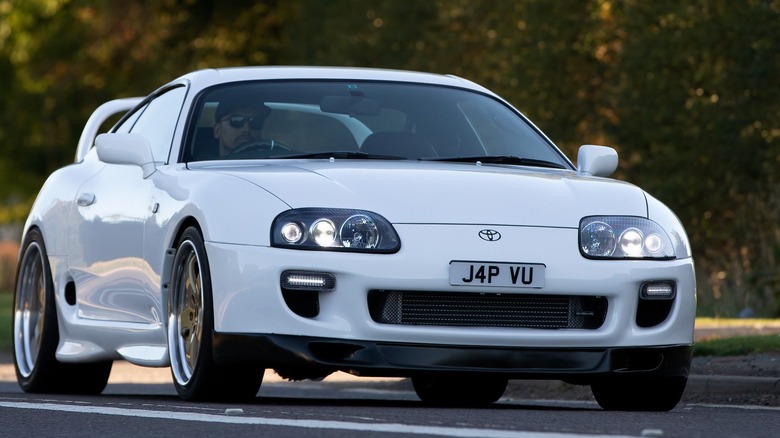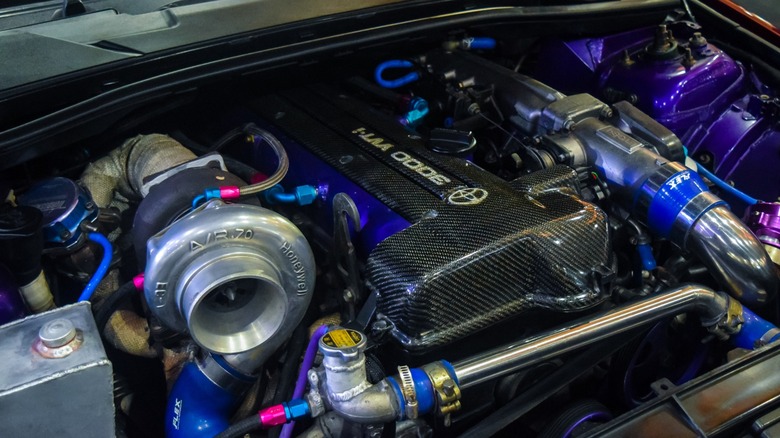Here's What Makes The Toyota Supra Mk4 One Of The Coolest JDM Cars Ever Built
When you ask someone to name an iconic Japanese domestic car, there's a really good chance they'll reply with "MK4 Toyota Supra." That's mark four, by the way. Not "em kay four." If you look at the sale price of MK4 (JZA80, in Toyota's internal nomenclature, or simply "A80" Supras), you'll quickly see that they have quite a cult following and a lofty resale value.
That begs the question: what makes the A80 Supra so desirable? Not many could have predicted at the time of its release that clean examples of this once-affordable Japanese sports car would be fetching north of $100,000 at auctions. What was potentially predictable, though, was the mass adoption of the A80 Supra platform for tuners and car modifiers that spans virtually every edge of the car scene from road racing to drifting and from Concours-level show car status to air-ride-laden SEMA builds. Let's take a look at what makes the MK4 Toyota Supra so iconic.
The iconic 2JZ-GTE
We'll touch on the styling of the MK4 Toyota Supra a little later. However, the basis of the Supra's fame and recognition starts with what's under the hood. The legendary Toyota 2JZ-GTE. For those unfamiliar with Toyota's engine names, the T in the middle of "GTE" stands for turbocharged.
The twin-turbocharged 3.0-liter inline six-cylinder 2JZ-GTE is renowned for its robust build quality, allowing tuners to crank power output through the roof without internal modification. Its popularity truly went through the roof with the tuner scene (especially after its feature in "The Fast and The Furious"), and the engine found its way under the hood of virtually every single car you could possibly think of. So, while the engine itself did transcend the JZA80 Supra chassis, it's undoubtedly the MK4 Supra's biggest claim to fame.
In stock form, Toyota advertised that the engine made 280 horsepower. However, in the late 1980s, Japanese automakers entered a so-called "gentleman's agreement" not to produce cars with more than 280 horsepower. Conveniently, a bunch of high-performance cars like the Supra and GT-R came with exactly that power output. It's no coincidence that buyers putting stock ones on dynos saw power output prove to be higher, but we digress. The big selling point is that stock-block 2JZ engines have been proven to have power levels nearing 1,000 horsepower, and there's virtually unlimited aftermarket support to make them whatever you want them to be!
Styling, transmission, and driving experience
Of course, a good engine only gets you so far if the rest of the drivetrain isn't as capable. Fortunately, the six-speed manual Getrag transmission found in the turbocharged Supra models is also notoriously robust. The stock differential and driveshaft are no slouches, either. So, with a reasonably affordable starting point and the potential to make tons of power with some modifications, it's easy to see why Japanese car fans took to the MK4 Toyota Supra. In addition, the styling is nothing to scoff at. The iconic rounded front end, complemented with massive headlamp assemblies, is certainly a unique design among other cars from its time.
The Supra is pretty large for a sports car. However, it's important to understand that it falls more into the grand touring sort of category. Toyota didn't design the Supra to be a track weapon so much as it designed it to be a fast and enjoyable driving experience for commutes and windy roads. They're fast and sporty but also comfortable and offer a good amount of trunk space. It even has back seats. They're uselessly tiny, but it has them!
Combining daily usability, huge potential for power output with some modification, and an engine that is virtually bulletproof (to an extent) made the MK4 Toyota Supra attractive to drag racers, standing-mile racers, road course racers, drifters, and virtually every other person interested in cars and modifications, cementing the Supra's legend status.


